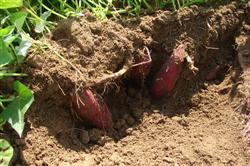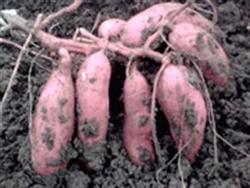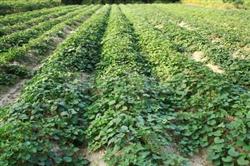The high yield of sweet potato depends on fertilization.

The demand of sweet potato for nitrogen, phosphorus and potassium varies with different growth stages. The absorption of nitrogen fertilizer was more in the period of stem and leaf growth, less in the period of root expansion, less in the middle of stem and leaf growth, and more in the period of root expansion, while the absorption of potassium fertilizer from planting to harvest was more than that of nitrogen and phosphorus, especially in the period of root expansion. Therefore, the fertilization of sweet potato should focus on this characteristic. The main results are as follows: 1. the application of sufficient base fertilizer should be based on farm manure, supplemented by chemical fertilizer, which should be fully mature. The amount of base fertilizer generally accounts for 60% to 80% of the total fertilizer application. Generally speaking, 667 square meters of fresh potato 2500-4000 kg should be fertilized with base fertilizer 3000- 4000 kg. And combined with the application of calcium superphosphate 15 25 kg, plant ash 100 150 kg, ammonium bicarbonate 6 10 kg and so on. The base fertilizer should be concentrated and layered, 60% of the base fertilizer should be applied to the bottom layer during deep ploughing, and 40% of the base fertilizer can be applied at the time of planting. The available fertilizer combined with base fertilizer should be concentrated in the hole along with the soil, so that the potato seedlings can be absorbed after survival. 2. The period, variety, quantity and method of seedling topdressing for sweet potato should be determined according to the appearance and needs of different growth periods. Specifically, we should catch up with the "five fertilizers". (1) Seedling fertilizer and seedling fertilizer are generally applied with quick-acting fertilizer, which is carried out in combination with seedling inspection and seedling replenishment 3-5 days after planting, by opening a hole of about 10 cm near the root of the potato seedling, applying a pinch of urea, that is, 1.5-3.5 kg per 667 square meters, watering and covering the soil immediately after application, or irrigating the root with 1% urea water to supplement the deficiency of less available fertilizer and slow fertilizer effect of base fertilizer. (2) after the strong vine fat sweet potato enters the strong vine stage, the underground part grows vigorously, the root tuber begins to form, and the fertilizer absorption is strong. In order to accelerate the expansion of leaf area and improve the photosynthetic production efficiency, the strong vine fertilizer should be applied 30-40 days after planting. The amount of fertilizer application is determined by soil fertility and seedling potential, and for those with poor growth, 667 square meters of ammonium sulfate 7.5-10 kg or urea 3.5-4.5 kg or ammonium nitrate 4.5 kg, potassium sulfate 10 kg or plant ash 100 kg. If the growth is better, the dosage can be reduced. Combined with fertilization, we should also do a good job of weeding and irrigation to prevent drought in time. (3) potash fertilizer is the main fertilizer for promoting potato fertilizer, which is usually applied 90 ~ 100 days after planting. Potassium application can effectively prolong the functional period of leaves, enhance the vigor of stems and leaves, improve photosynthetic efficiency, promote the transport of photosynthates and promote the expansion of potato lumps. Generally available potassium sulfate every 667 square meters to apply 10 kg, or plant ash 100 kg 150 kg. After application, one watering should be carried out to promote its fertilizer effect as soon as possible. (4) crack fertilizer has a significant yield-increasing effect on sweet potatoes with obvious premature senescence during the expansion period. Crack fertilizer is generally irrigated along the cracks with ammonium sulfate 4 kg per 667 square meters, 400 kg of water, or 250 kg of mature human feces and urine, 750 kg of water. (5) in the middle stage of foliar sweet potato block expansion, the function of root fertilizer absorption begins to decline. At this time, the method of extra-root catch-up fertilizer should be used to supplement fertilizer. Generally, 2%-5% calcium superphosphate leaching solution or 1% potassium phosphate solution or 0.3% potassium dihydrogen phosphate solution or 5%-10% plant ash filtrate are sprayed after 3 p.m., spraying 75 kg every 667 square meters, once every 15 days and twice in a row. Precautions: 1. Sweet potato is a chlorine-free crop, so when selecting fertilizer, we should pay attention to not using the fertilizer containing chlorine; 2, ammonium bicarbonate should not be spread and applied on the surface, it can be made into mixed fertilizer particles; 3, when applying human and animal feces and urine, it should be fully mature; 4, plant ash can not be mixed with nitrogen and phosphorus fertilizer, and should be applied separately.
- Prev

Five measures for High yield cultivation of Sweet Potato
The selection of excellent varieties of high-quality potato seedlings can not only improve the survival rate of planting and early fruiting, but also significantly increase the yield of sweet potato, which is generally more than 10% higher than that of weak seedlings. The selection and purchase of sweet potato seedlings should be considered from three aspects: appearance, height and weight. High-quality sweet potato seedlings generally have large and thick leaves and dark green leaves.
- Next

What problems should be paid attention to when turning over sweet potato seedlings?
First, in the case of sufficient water, there are secondary roots at the stem nodes, and the secondary roots can absorb a large amount of nutrients and water, so that the vegetative growth is exuberant, the vines grow excessively, and the reproductive growth is inhibited, and the potato grows slowly. At the same time, the secondary root will also grow small potato pieces, resulting in a lack of nutrients, the phenomenon that "no one has enough to eat".
Related
- Where is it suitable to grow horseradish in China? it is expected to see the middle altitude horseradish in Alishan.
- How to prevent tomato virus disease reasonably? (Control methods included)
- Many people like to plant towel gourd on the balcony. What are the main points of this method and management?
- What crops can chili peppers be mixed with?
- Fertilization techniques and matters needing attention in Tomato
- What are the grafting techniques for peach seedlings in spring?
- Harm and control methods of root swelling disease of Chinese cabbage
- What are the pests of sweet potatoes? How to prevent and cure it?
- Symptoms, causes and Control methods of navel Rot in Tomato
- The cause of "Cucumber rotten bibcock" in Farmers' planting Cucumber and its Control Plan

